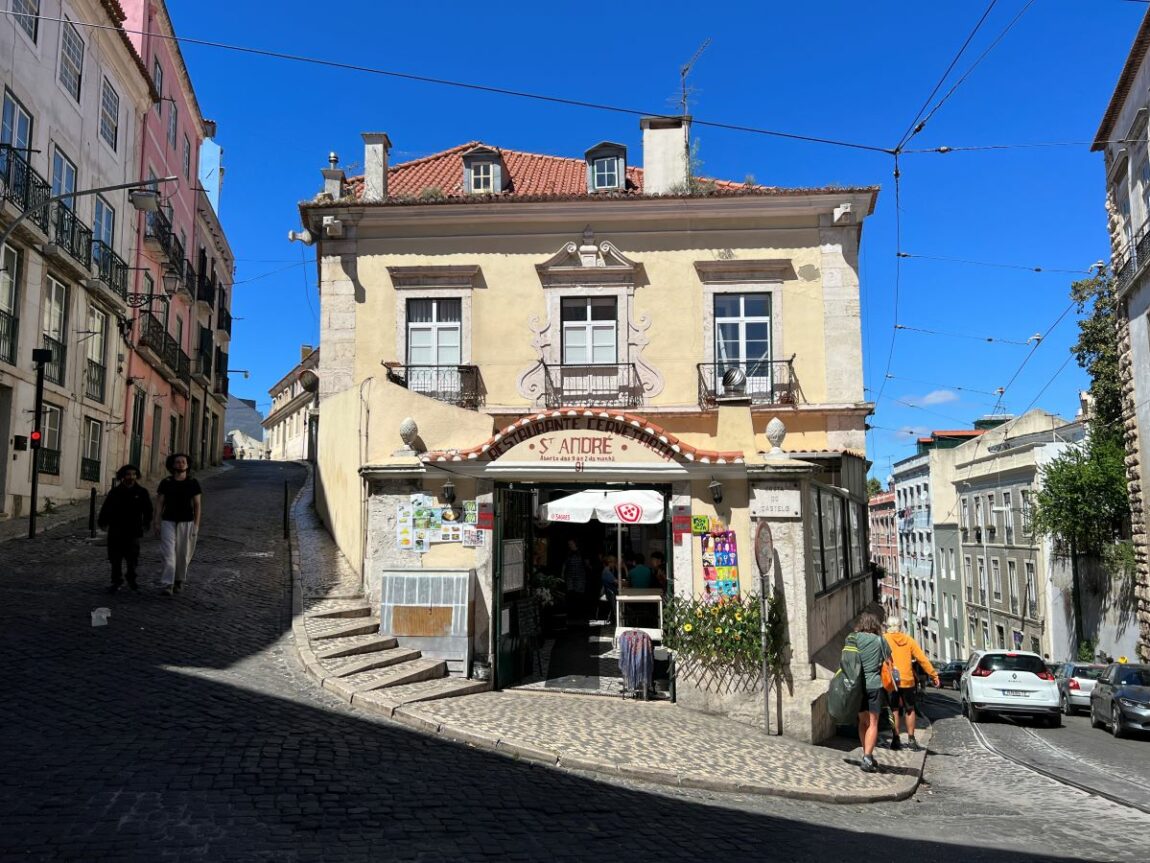
Labyrinthian streets, terracotta roofs and panoramic viewpoints – Alfama is one of the best neighborhoods to explore in Lisbon.
Alfama is the oldest and most picturesque neighborhood in Lisbon, so it shouldn’t be a surprise that is packed with tourists snapping photos all around and walking its labyrinthian streets. This iconic neighborhood is ideal for your stay as it is essentially in the middle distance of almost every attraction in the city. Colorful houses with terracotta roofs, traditional coffee shops, panoramic viewpoints and charming boutique stores, make this neighborhood a must visit while in Lisbon.
In fact, many of “the” postcard or social media images you first see of Lisbon are taken directly from Alfama. If you are staying in Lisbon for a few days, maze-like Alfama is best explored on a walking tour – there is nothing better than “getting lost” in this neighborhood streets and finding hidden gems in every corner.
Alfama is located on the slope between the São Jorge Castle and the Tagus river. If you are staying in another neighborhood, you can either walk up or take the historic no. 28 tram which winds through Alfama on its way up. Thanks to its sturdy foundations, it was nearly the only neighborhood in Lisbon which wasn’t greatly affected by the 1755 earthquake.
Things to do in Alfama
Explore the Se Cathedral: Featuring different architectural styles, this cathedral is the oldest and most important Roman Catholic Cathedral in the capital. The Se Cathedral has survived several natural disasters through time and therefore has undergone multiple restorations. Due to its location, it is the most popular spot to take a picture, as the tram gently glides past the cathedral’s entrance.
Inside the cathedral you can find the fountain where Saint Anthony of Padua was baptized along with a 14th century gothic chapel and 14th-century sarcophagi. Additionally there is a unique cloister which features remains of its Roman, Arab, and Medieval past. If you go inside, do not forget to visit its balcony featuring views of Lisbon.
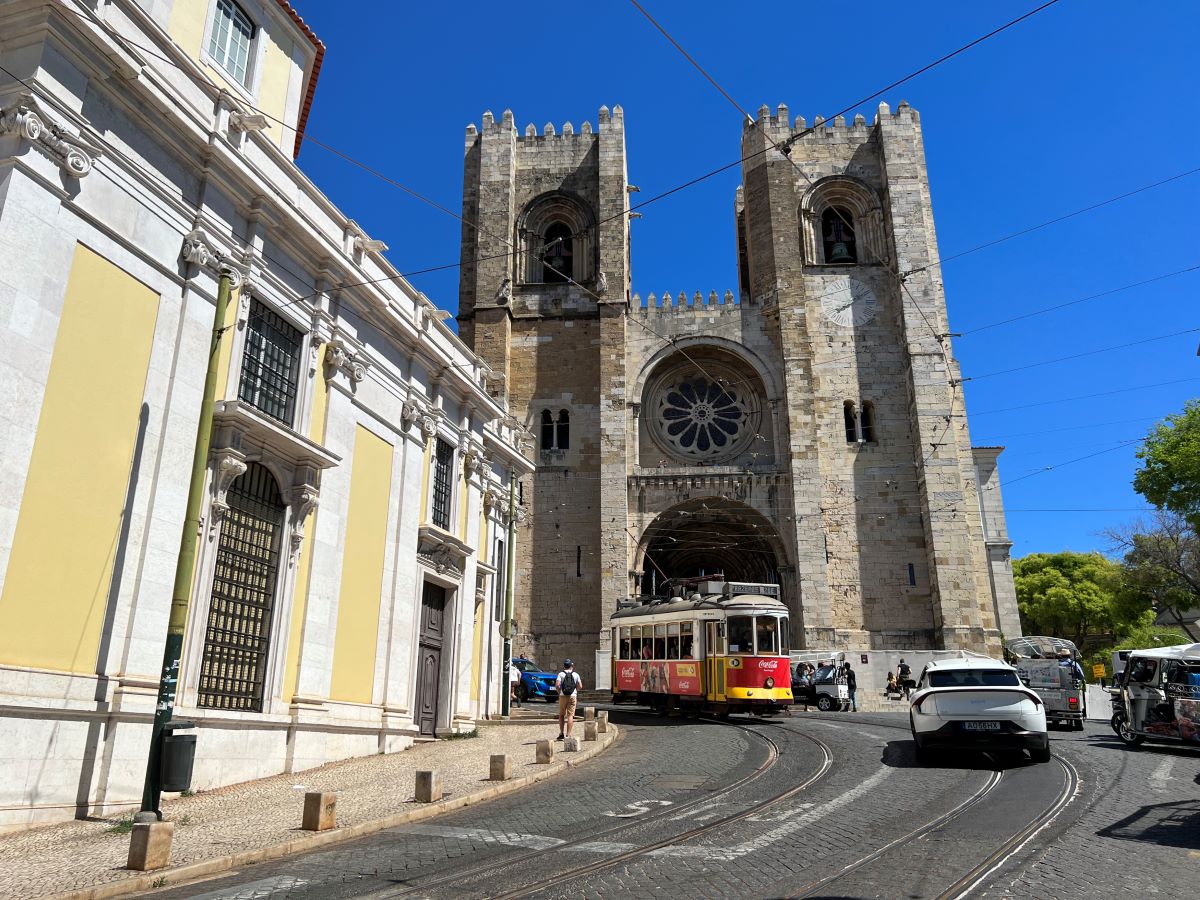
Se Cathedral, Lisbon’s most iconic religious building. Credit: Carry on Caro
Walk up to the Castelo de São Jorge: This is probably Alfama’s most popular attraction which has been dominating Lisbon’s skyline since the 11th century. It’s quite popular and full of tourists but given its size you won’t feel overwhelmed.
See if you can spot the peacocks roaming around the towers showing off their colorful feathers.
Inside the Castelo, take time to explore its museums, walls, towers, and moat. For me, the best part of this Moorish castle are the panoramic views over Lisbon and its various districts. As of April 2023, the cost to go in was 13 euros.

Castelo de São Jorge. Lisbon, Portugal. Credit: Carry on Caro
Get sweeping views at the Miradouro das Portas do Sol: This scenic viewpoint offers panoramic city views of the traditional Alfama houses with terracotta roofs, the towers of the Monastery of St. Vincent, and the dome of the National Pantheon in the background.
There is also a statue of St. Vincent; renowned as Lisbon’s patron saint and who is holding a boat with two ravens, the symbols of the city. This is a great spot to stop for a drink where you can enjoy marvelous views and the neighborhood’s bustling atmoshphere. You can combine a visit to the very close to the Miradouro de Santa Luzia as they are virtually next to each other. I recommend you visit this viewpoint in the afternoon when the sun shines into the terracotta roofs of Alfama’s houses.
Read blog: Miradouro das Portas do Sol: The best view of Alfama
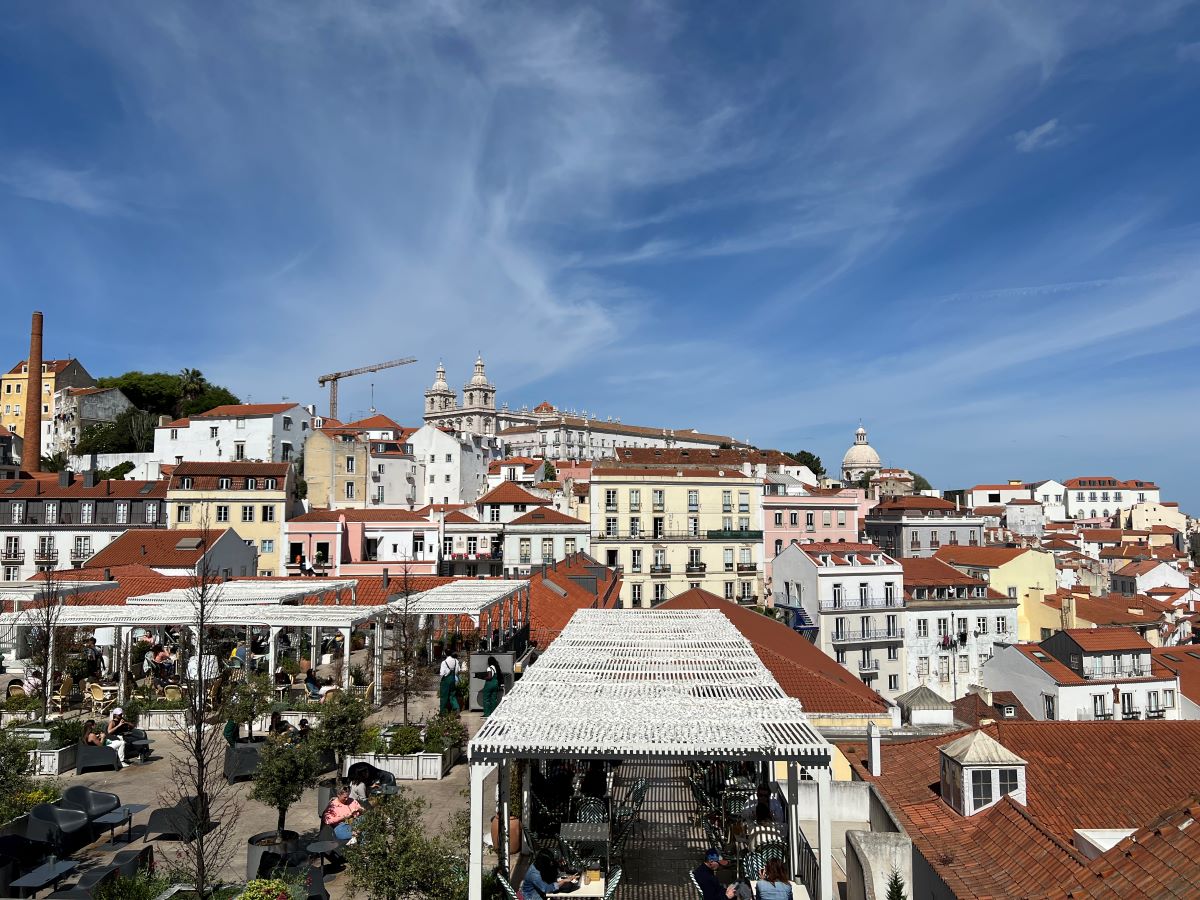
Miradouro das Portas do Sol. Lisbon, Portugal. Credit: Carry on Caro
Explore the Miradouro de Santa Luzia: Miradouro de Santa Luzia is located a five-minute walk from the Miradouro das Portas do Sol. Because it’s small in size, this Miradouro gets packed with tourists at all times.
Head to this viewpoint to enjoy more sweeping view over the Tagus river, the terracotta roofs, and a the occasional local playing a Fado on their guitar. The views from the Miradouro de Santa Luzia are not as expansive as from the Miradouro das Portas do Sol but it will give you a chance to capture views from different angles. It’s will also give you a great picture for social media as the picturesque viewpoint has some stunning tilework.
This Miradouro is located next to the church of Santa Luzia. There are two tile murals that can be found on the church’s southern wall: one of them shows Lisbon before its destruction by the 1755 earthquake, and the other illustrates the Crusaders storming the castle in 1147. Just past the viewpoint, some locals will prop up an impromptu ginjinha stand, the famous cherry liquor drunk in Portugal.
Stop by the Miradouro da Graça: The Miradouro da Graça has one of the best views of the Castelo de São Jorge. And it’s about a 7-minute walk from the Miradouro de Santa Luzia. Here is a great place to grab a drink while enjoying panoramic views during sunset, when it becomes more popular with locals and tourists alike. Locals will congregate here and some even put on performances.
Take the iconic tram 28: Photos of trams are featured in almost every postcard showing Lisbon and can be found in many places of the city. Tram 28 is full of tourists most of the time who decide to hop on this iconic tram. Tram 28 connects Martim Moniz with Campo Ouriqu goes on its route through Graca, Alfama, Baixa and Estrela.
Remember this tram gets packed so if you want to secure a seat it’s better to get on in the early stops! Given their ability to squeeze through Lisbon’s narrows streets, the trams have survived the competition from cars and buses as the preferred mode of transport. The average intervals between each vehicle is 9 to 12 minutes and the entire trip can take up to an hour.
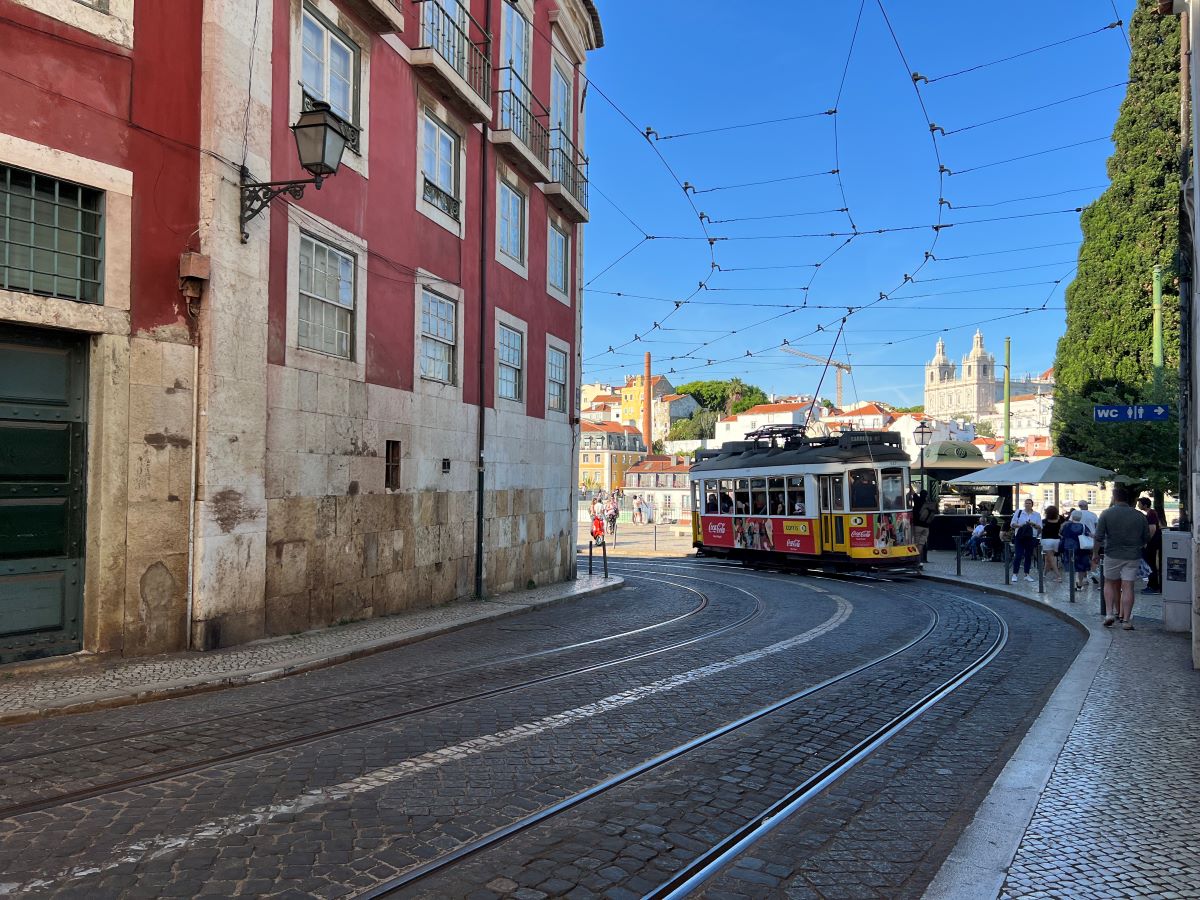
Visit the Fado museum: Fado was born in Alfama. Fado is a music genre that can be traced back to the 1820s. Fado is characterized by longing, mournful and melancholic tunes and lyrics and there are various places where live fado can be heard at night. The Fado museum opened in 1998 and here you can explore collections donated by singers, lyricists, musicians, composers that will let you see and experience Fado. Also, don’t miss the chance to listen to this characteristic music while visiting Lisbon.
Explore the church and monastery of Sao Vincente de Fora: This Church, built in 1582, has the world’s most extensive collection of baroque tiles. It is dedicated to Saint Vincent of Saragossa, who is the patron saint of Lisbon, and whose relics were brought from the Algarve to Lisbon in the 12th century. From the rooftop there is a nice view of Alfama, the Tagus river and the dome of the National Pantheon.
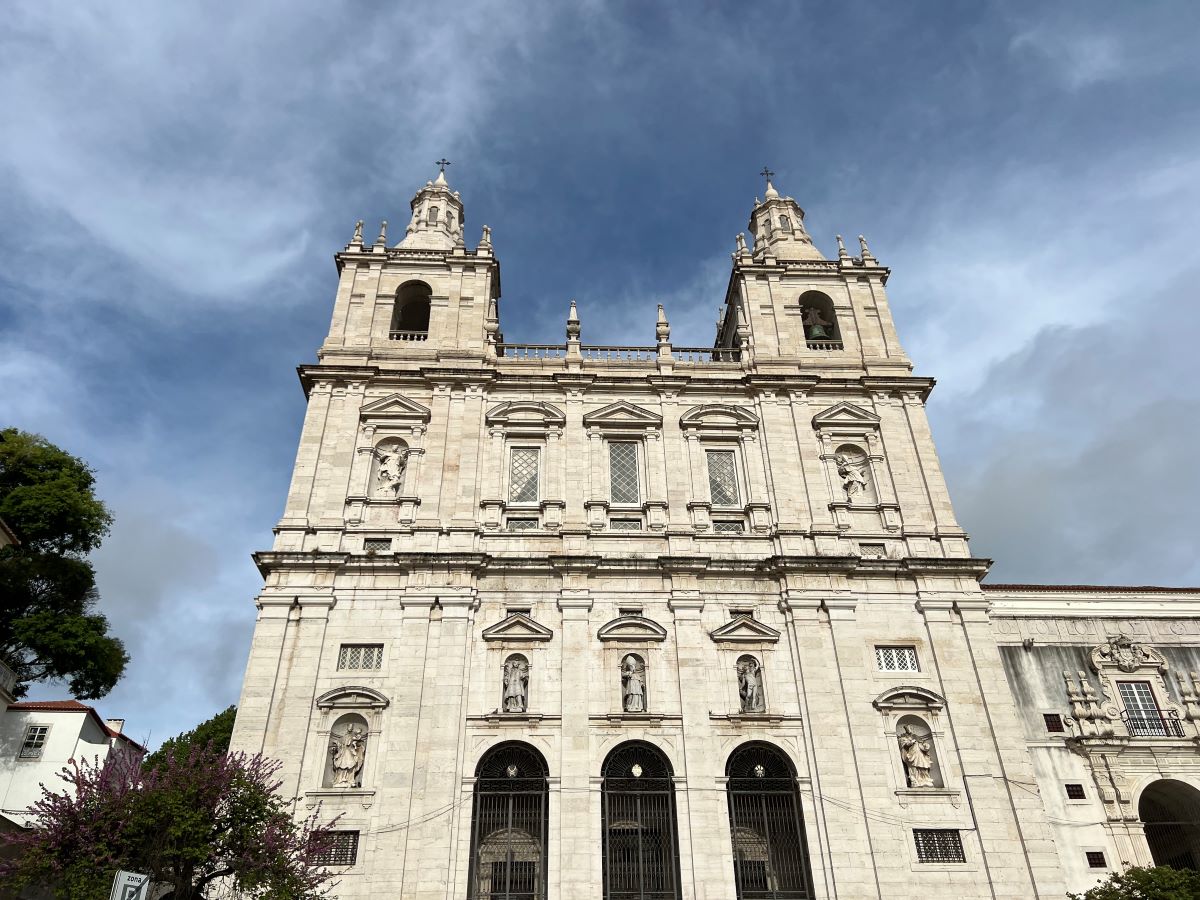
Monastery of São Vicente de Fora. Lisbon, Portugal. Credit: Carry on Caro
Tips for visiting Alfama
Wear comfy shoes: In Alfama and in Lisbon more generally, the streets are extremely steep,so I imagine that people living in Lisbon don’t need a gym and get their exercise by walking up and down the streets. There is a good reason why Lisbon is also called “The City of Seven Hills”.
Therefore, we recommend you bring comfortable shoes such as sneakers. No high heels or flip flops are recommended as the cobblestones streets might make you trip. Keep in mind any funiculars will normally be jammed packed, so take your time walking uphill.
Head to Alfama in the early morning: Since we stayed in a hotel in Alfama for a few days, we had the chance to experience this neighborhood early in the morning when the floods of tourists are still sleeping. This is a great time to wander its street and have the neighborhood for yourself only – at least for a few hours!
We are part of several affiliate programs including Amazon and Viator which means that we will earn a small commission at no extra cost to you if you make a purchase through the links included in this post.
